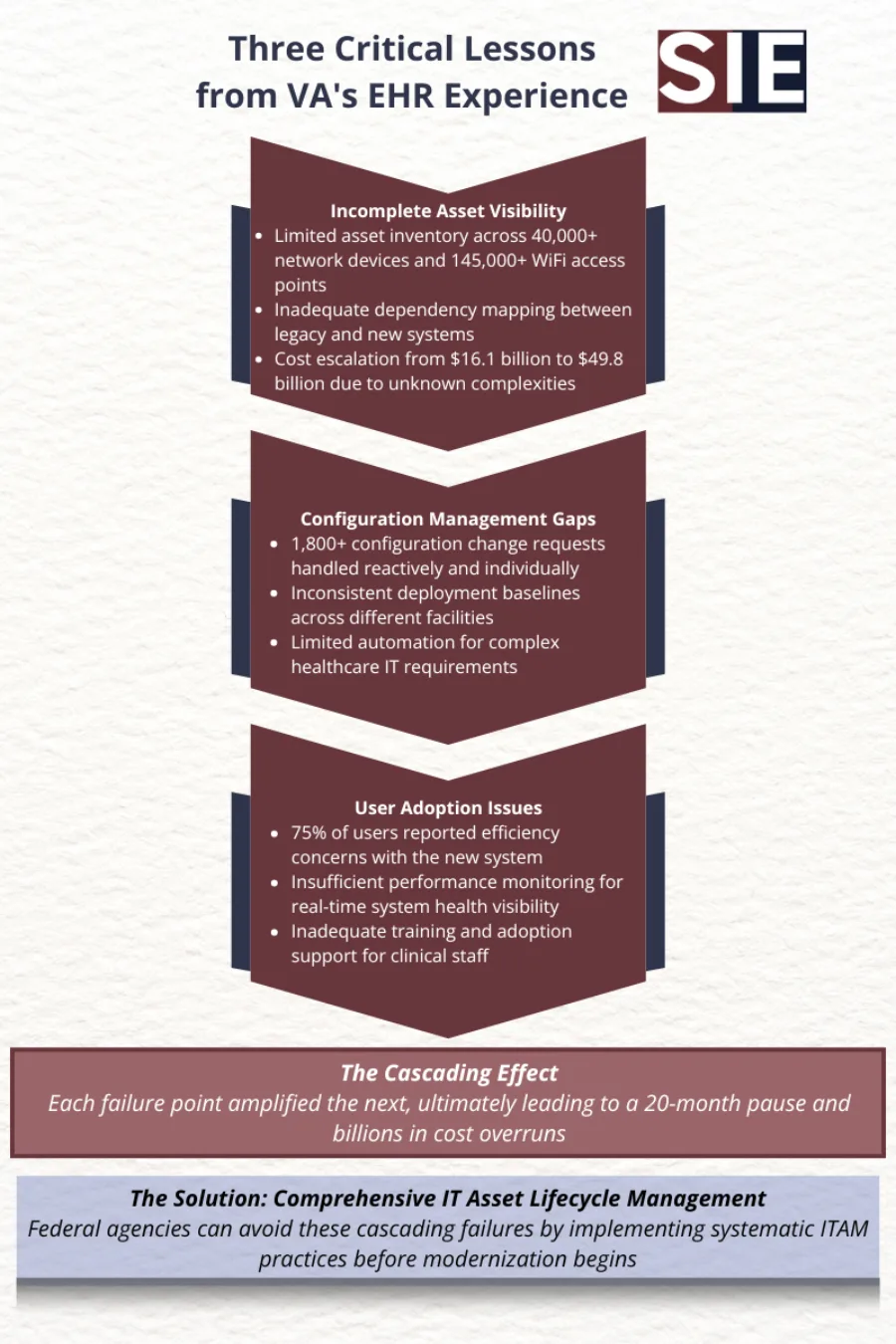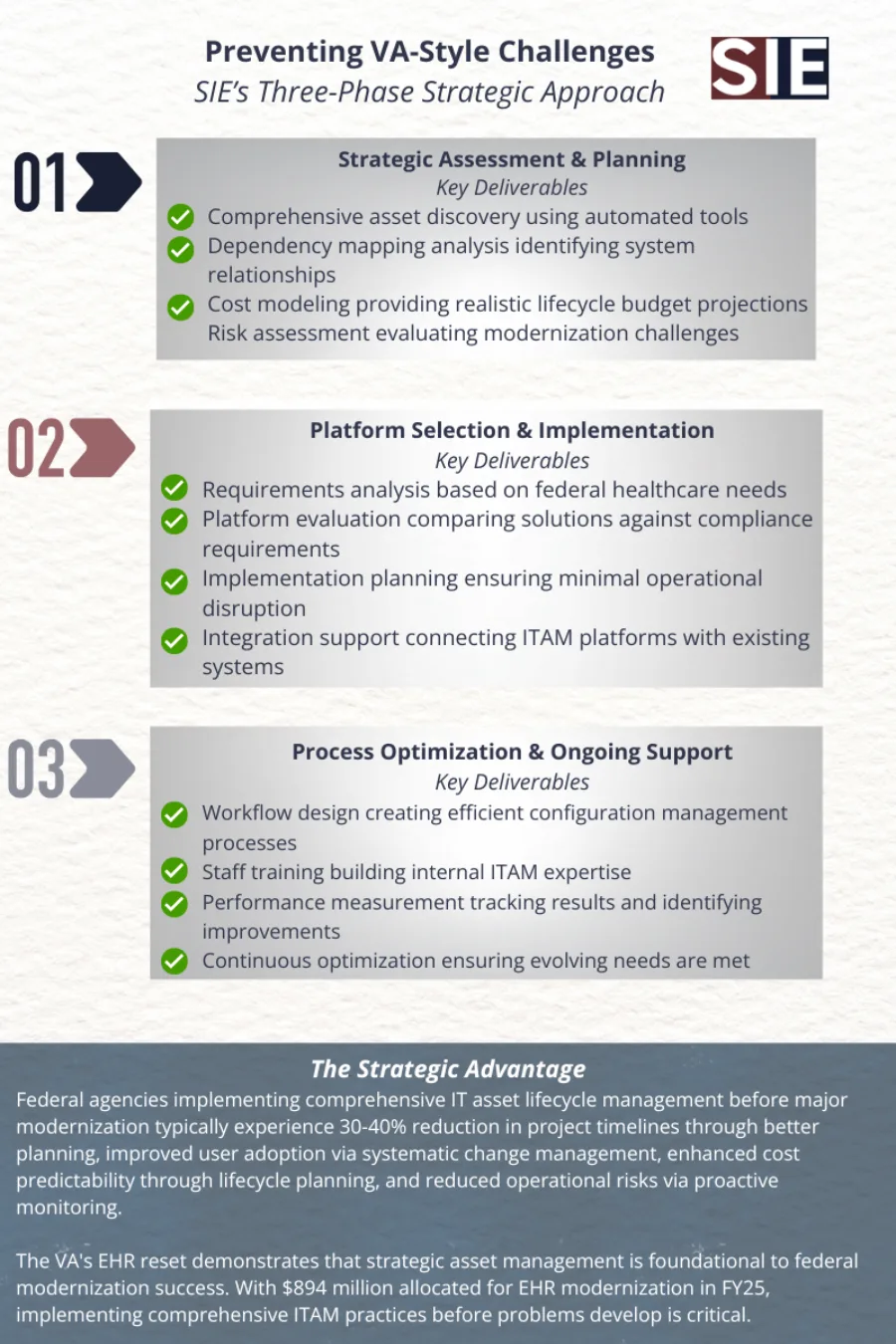When the VA paused EHR deployments in April 2023, several federal IT asset management gaps became apparent:
Beyond the Pause: What VA's EHR Reset Means for IT Asset Lifecycle Management
The Department of Veterans Affairs' 20-month Electronic Health Record Modernization (EHRM) pause offers critical lessons about IT asset lifecycle management in federal environments. As the VA prepares to resume deployments in 2026, understanding this strategic reset provides valuable insights for federal IT leaders.
Incomplete Asset Visibility
The most significant challenge was insufficient visibility across the VA's complex infrastructure:
- Limited asset inventory - The VA's infrastructure spans 40,000+ network devices and 145,000+ WiFi access points across thousands of facilities
- Inadequate dependency mapping - Relationships between legacy and new systems weren't fully understood
- Cost escalation - Original estimates of $16.1 billion evolved to $49.8 billion
Configuration Management Gaps
The VA currently manages 1,800+ configuration change requests, revealing:
- Reactive change processes handled individually rather than systematically
- Inconsistent deployment baselines across different facilities
- Limited automation for complex healthcare IT requirements
User Adoption Issues
With 75% of users reporting efficiency concerns, the VA faced:
- Insufficient performance monitoring for real-time system health visibility
- Weak feedback integration from clinical workflow needs
- Inadequate training and adoption support for staff
Essential Software Features: What Federal Agencies Need
Based on the VA's experience, federal healthcare organizations should prioritize VA IT asset management platforms offering:
Comprehensive Asset Discovery
- Automated network scanning for complete inventory across healthcare environments
- Real-time dependency mapping showing system interconnections
- Medical device integration for FDA-regulated equipment
- Configuration Management Database (CMDB) as the single source of truth
Healthcare-specific Capabilities
- Clinical workflow integration connecting IT assets to patient care processes
- HIPAA compliance automation with privacy and security monitoring
- High-availability tracking ensuring 24/7 system reliability
- Emergency response capabilities maintaining continuity during critical situations
Performance Analytics
- Predictive analytics identifying issues before they impact operations
- User experience tracking measuring efficiency and satisfaction
- Optimization recommendations based on usage patterns
- ROI measurement demonstrating technology investment value
Key Lessons: Critical Insights for Federal IT Leaders
The VA's reset experience provides four essential lessons for federal IT deployment success:
1. Asset Discovery Must Come First
Complete environmental visibility prevents unexpected integration challenges, cost overruns, and post-deployment performance issues.
2. Systematic Change Management is Essential
The 1,800+ pending configuration requests demonstrate the need for automated workflows, standardized procedures, and stakeholder coordination.
3. User Adoption Requires Strategic Focus
Technical deployment without user acceptance creates operational challenges. Success requires clinical workflow analysis, comprehensive training, and feedback integration.
4. Total Lifecycle Cost Planning is Critical
The cost evolution from $16.1B to $49.8B highlights the need for comprehensive cost modeling, vendor management, and regular budget monitoring.
How The SIE Group Can Help: Strategic ITAM Partnership
The SIE Group's federal ITAM expertise provides comprehensive support to avoid VA-style challenges:
Strategic Assessment and Planning
- Comprehensive asset discovery using automated tools to catalog complete IT infrastructure
- Dependency mapping analysis identifying system relationships and potential risks
- Cost modeling providing realistic lifecycle budget projections
- Risk assessment evaluating modernization challenges
Platform Selection and Implementation
- Requirements analysis based on specific federal healthcare needs
- Platform evaluation comparing solutions against technical and compliance requirements
- Implementation planning ensuring minimal operational disruption
- Integration support connecting ITAM platforms with existing systems
Process Optimization and Ongoing Support
- Workflow design creating efficient configuration management processes
- Staff training building internal ITAM expertise
- Performance measurement tracking results and identifying improvements
- Continuous optimization ensuring evolving needs are met
The Strategic Advantage
Federal agencies implementing comprehensive IT asset lifecycle management before major modernization typically experience:
- 30-40% reduction in project timelines through better planning
- Improved user adoption via systematic change management
- Enhanced cost predictability through lifecycle planning
- Reduced operational risks via proactive monitoring
Moving Forward
The VA's EHR reset demonstrates that strategic asset management is foundational to federal modernization success. With $894 million allocated for EHR modernization in FY25, implementing comprehensive ITAM practices before problems develop is critical.
Federal agencies can leverage these lessons to ensure modernization efforts achieve sustainable success while avoiding the challenges experienced by the VA.
Ready to apply these lessons to your modernization efforts? Schedule a no-cost assessment with The SIE Group to review your IT asset lifecycle management readiness and develop a strategic roadmap for success.
About The SIE Group
The SIE Group partners with federal agencies to implement comprehensive IT asset lifecycle management solutions that prevent costly modernization challenges and ensure successful technology deployments. Our specialized expertise in government IT modernization and proven ITAM methodologies help federal organizations avoid the pitfalls that led to the VA's $49.8 billion EHR setbacks.
Complete VA ITAM Insights Series: Federal IT Asset Management Best Practices
- VA Software License Optimization: How to Multiply $65 Million in Federal Savings - Proven federal software asset management strategies for multiplying government software licensing savings and budget optimization
- VA Cybersecurity ITAM: $6.3 Billion Federal Technology Investment Protection Strategy - Strategic federal IT asset management for comprehensive government cybersecurity protection and security ROI maximization
- VA Enterprise ITAM: Managing 40,000+ Federal IT Devices Across 2,000+ Government Facilities - Federal enterprise IT asset management for unified visibility across distributed government environments and large-scale federal infrastructure
- VA Configuration Management ITAM: 1,800+ Federal IT Configuration Optimization Opportunities - Federal configuration management best practices for transforming government IT challenges into strategic opportunities
- Federal EHR Modernization Lessons: VA IT Asset Management Reset Strategy - Critical federal IT modernization lessons from the VA's 20-month Electronic Health Record strategic pause and government ITAM implementation
- Federal IT Modernization Cost Control: $50 Billion VA EHR Prevention Strategy Through Strategic ITAM - Federal IT modernization best practices for preventing government technology overruns through strategic federal asset management
Schedule a no-cost federal ITAM assessment and government technology optimization consultation to discover your agency's federal IT asset management optimization opportunities.

